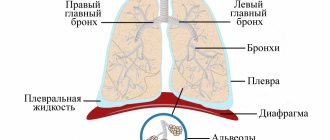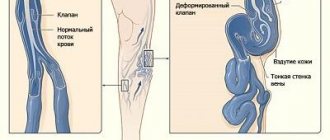In the literature you can find a description of more than 400 methods of surgical treatment of hallux valgus. In the past, podiatrists combated hallux valgus by surgically removing the articular heads, which resulted in severe impairment of foot function. Therefore, today doctors prefer to perform less traumatic operations.
X-ray.
What is hallux valgus? Initially, Hallux Valgus causes only the big toe to become bent. As a result, a person increases the load on the heads of the 2-4 metatarsal bones, which leads to hammertoe deformity of the II-V fingers. Timely surgical treatment helps to avoid this unpleasant phenomenon.
Types of foot surgeries
Operations performed for hallux valgus deformity can be divided into minimally invasive and reconstructive. The former are less traumatic, but are effective only for exostoses and initial deformation. Minimally invasive surgical interventions are performed through two or three punctures measuring 3-4 mm.
Scar after intervention.
Reconstructive interventions help to cope with severe hallux valgus deformity, accompanied by changes in the position of the bones of the foot. Such operations are more invasive and involve more trauma. They are performed through a 2-4 cm long incision on the medial surface of the foot. During surgery, the doctor restores the normal position of the metatarsal bones and fixes the first metatarsocuneiform joint in the correct position.
Table 1. Types of operations.
| Features of the event | Indications | |
| On soft tissues | During the operation, the doctor works only with the muscles, tendons and joint capsule. | Hallux Valgus I degree without deformation of the metatarsal head. |
| On the bones | The essence of such surgical interventions is to file the bones and/or perform an osteotomy. | Hallux valgus deformity II-III degree. |
| Combined | They involve simultaneous removal of bone growths and plastic surgery of ligaments. | Severe Hallux Valgus with dysfunction of the foot. |
Minimally invasive intervention.
During minimally invasive operations, the surgeon uses micro-instruments that allow complex manipulations of the ligaments and joint capsule. If necessary, he files the bones using micro-mills, which vaguely resemble dental instruments.
How is the procedure done?
Traditional surgery to correct big toe deformities involves a 5-7 cm incision on the inside of the foot.
The surgeon makes a 3 mm incision in three places at the base of the big toe with minimal damage to surrounding tissue. A lateral sharpening phrase is then introduced through these incisions and an osteotomy is performed on the first metatarsal as well as the proximal phalanx of the big toe. Once the deformity is corrected and the finger is in the correct position.
The entire procedure takes place under general anesthesia and takes from 30 to 60 minutes.
Name of surgical techniques
In the initial stages of the disease, doctors try to perform minimally invasive operations. After them, the patient recovers quickly and returns to his normal lifestyle within 3-4 weeks. With advanced hallux valgus deformity, the need for more complex surgical interventions arises.
Let's see which of them are most often used in modern orthopedics.
Operation McBride
The most popular among all surgical interventions on the soft tissues of the foot. Its essence is to move the tendon m. adductor halluces on the head of the first metatarsal bone. This allows you to bring the metatarsal bones closer together and restore the normal muscle-tendon balance of the foot.
McBride.
Unfortunately, the abductor pollicis muscle is unable to withstand constant stress. This is why the relapse rate after McBride surgery is quite high. If a person does not eliminate the effect of provoking factors, he will soon develop Hallux Valgus again. Wearing orthopedic shoes, avoiding heels and heavy physical work helps to avoid this.
In case of pronounced deformities, the McBride operation is supplemented with SCARF osteotomy of the first metatarsal bone.
SERI
Refers to minimally invasive operations. During surgery, patients undergo a transverse osteotomy through a 1 cm long skin incision. After this, the distal bone fragment is shifted in the lateral direction and fixed using a special wire.
SERI.
CHEVRON
During the operation, the surgeon performs a V-shaped osteotomy
. He saws the first metatarsal bone in the area of the head, and connects the bone fragments using special titanium screws. Since the fixation is very strong, the patient does not need plaster immobilization in the postoperative period.
CHEVRON.
Note that Chevron osteotomy is effective only for minor deformities of the first toe. Nowadays, it is used less and less in orthopedics. Instead, most doctors perform a Scarf osteotomy.
SCARF
The Scarf Z-shaped osteotomy is the gold standard for the treatment of hallux valgus. It allows you to set the head of the metatarsal bone at the desired angle. During surgery, doctors also remove deformation of the joint capsule and change the direction of some tendons.
SCARF.
When Scarf surgery is not enough, surgeons perform a proximal wedge osteotomy or arthrodesis.
Important! In most patients with hallux valgus, doctors detect callus (exostosis). The growth is localized on the medial surface of the head of the first metatarsal bone. As a rule, it is removed during all operations, including minimally invasive ones.
Do not confuse cutting down a bone spur with an osteotomy. These are two completely different manipulations. The goal of the first is to remove a cosmetic defect, the second is to restore the normal functional state of the foot. Remember that callus removal (Schede procedure) will not cure you of Hallux Valgus.
Where in Ufa is surgery performed to remove bunions on the feet?
The Yuhelp clinic employs specialists who perform operations for diseases such as Hallux Valgus (removal of bones on the feet). The clinic has created comfortable conditions for patients to stay, and also has laboratory and diagnostic departments. All operations for Hallux Valgus are performed under the supervision of experienced anesthesiologists.
We help our patients:
- return to a full life;
- eliminate obvious cosmetic defects;
- avoid subsequent disability.
You can make an appointment with a doctor to receive professional advice on the treatment of hallux valgus on our website by filling out a special feedback form. Or call us by phone: +7 . And also write to Whatsapp: +7 .
Arthrodesis for hallux valgus deformity
Arthrodesis is the complete immobilization of the metatarsal-wedge joint by connecting the bones that form it. The operation is performed on persons with transverse-spread deformity and Hallux Valgus with hypermobility of the first metatarsocuneiform joint.
Test to detect pathological mobility:
- hold the II-V metatarsal bones with the fingers of one hand;
- with the other hand, take the first metatarsal bone and try to move it in the dorsal-plantar direction;
- look how much you managed to move it;
- displacement of the bone by more than one sagittal dimension of the thumb indicates the presence of hypermobility.
Arthrodesis is the most traumatic operation, involving complete removal of the metatarsocuneiform joint. It is done only as a last resort when other methods are ineffective.
In what cases is surgery necessary?
Surgical treatment is indicated in the following situations:
- severe pain that limits daily activities;
- inflammatory processes, chronic swelling in the joint of the first finger, which are not eliminated by taking medications;
- inability to wear regular shoes;
- restrictions on the movements of the first finger - the inability to bend or straighten it.
Most patients with hallux valgus note significant improvements from conservative treatment methods and selection of the right shoes. But if these methods do not produce an effect, especially in elderly patients, it is necessary to decide on surgical intervention.
Surgery for hammertoe deformity
As is known, in the later stages of Hallux Valgus it is combined with hammertoe deformity of the II-V fingers. It looks unattractive and negatively affects the functions of the foot. To correct it, a number of surgical interventions are used.
These include:
- Closed redressing.
The essence of the technique is to forcibly correct the defect non-surgically. Unfortunately, redressal has little effect, and relapses often occur after it. - Tenotomy or tendon transposition.
Operations are performed on the ligaments of the foot. Their skillful intersection or movement allows you to correct hammertoe deformity. - Bone resection.
During surgery, doctors excise the base of the middle or head of the main phalanx. This allows you to get rid of excess bone mass and eliminate deformation. - Weil or Wilson osteotomies.
They resemble Scarf and Chevron operations, but are performed on the II-V metatarsal bones. Surgeons cut them open and then fix the bone fragments with titanium screws.
Osteotomy is most effective in treating hammertoe deformity. This is what is performed in the most severe and advanced cases.
Recovery period
Patients are allowed to get out of bed the very next day after surgery. At first they are allowed to walk only in Baruk's shoes.
Baruk's shoes.
In the first days after surgery, patients are under the supervision of the attending physician. They are discharged from the hospital within 2-3 days. If a person was given non-absorbable sutures during the operation, they are removed after 10-14 days.
Regarding footwear, patients are required to wear orthotics for at least 3 months. You can wear heels only six months after surgery. However, their height should not exceed 6 cm.
Will I be able to wear high heels after bunion surgery?
After the rehabilitation period is over, you will be able to occasionally wear high-heeled shoes. It is not recommended to do this on an ongoing basis due to excessive load on the forefoot, which can lead to relapse of the deformity and progression of arthrosis of the 1st metatarsophalangeal joint. It is a bad idea to perform surgery on a bunion for cosmetic reasons, since if there was no pain before the operation, then it may appear as a result of scarring in the intervention area after the operation. Wearing high-heeled shoes and shoes with a narrow toe increases the risk of recurrence of the deformity in the future.
Cost of foot surgery
The cost of surgical treatment depends on the degree of deformity, the type and complexity of the operation, the level of the medical institution and the qualifications of the specialists working there. Removal of exostosis in Moscow costs from 40,000 to 50,000 rubles. Prices for reconstructive operations start at 70,000 rubles. Please note that the price does not include preoperative examination, specialist consultations, consumables and rehabilitation.
If you want to have surgery abroad, pay attention to the Czech Republic. Treatment there will cost you in euros including rehabilitation. In Germany and Israel, the same operation will cost much more.
Preparing for surgery
If you decide to have surgery, then you need to undergo a full examination - blood and urine tests, a chest x-ray, and an ECG. Based on the results of these studies, the therapist will make a conclusion about the state of your health. Talk to your doctor about the medications you take regularly: some should be continued, while others should be stopped before surgery.
Special radiographs of the feet should be with you during the operation - this can help during the intervention.











